Compliant Learning Resources: Assessment Workbook 3 for TAE40116
VerifiedAdded on 2023/04/06
|96
|15315
|278
Homework Assignment
AI Summary
This document is an assessment workbook for the TAE40116 Certificate IV in Training and Assessment, produced by Compliant Learning Resources. It outlines the principles of competency-based assessment, including fairness, flexibility, validity, and reliability. The workbook covers various aspects of assessment, such as planning, developing, and validating assessment tools. It includes knowledge assessments, practical assessments, and case studies to provide a comprehensive understanding of the assessment process. The workbook also addresses the units of competency TAEASS401, TAEASS403, TAEASS502, TAEASS402, and TAELLN411, and provides instructions and resources for both assessors and learners. The document emphasizes the importance of reasonable adjustments for learners with disabilities and provides guidelines for collecting and evaluating evidence.
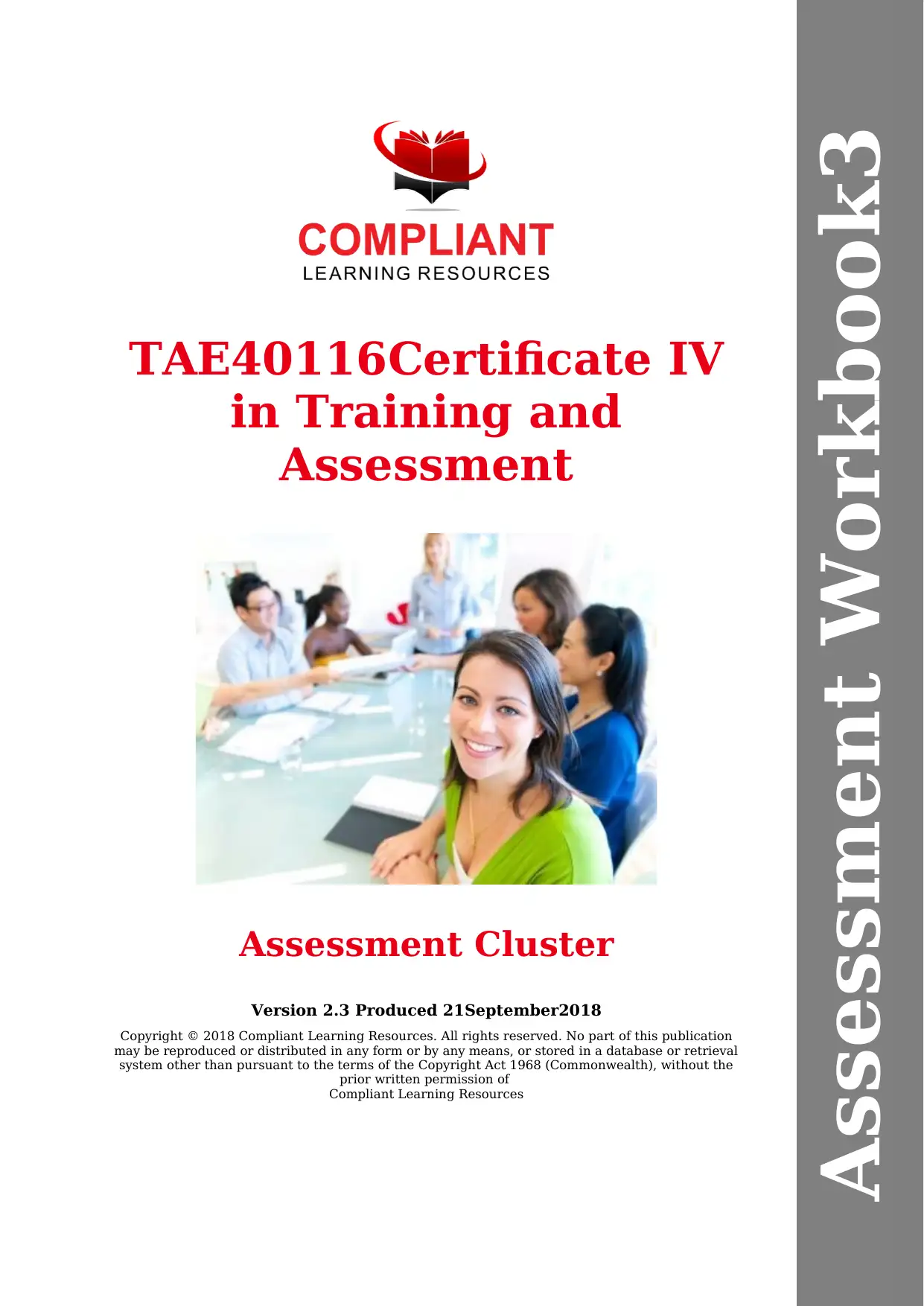
TAE40116Certificate IV
in Training and
Assessment
Assessment Cluster
Version 2.3 Produced 21September2018
Copyright © 2018 Compliant Learning Resources. All rights reserved. No part of this publication
may be reproduced or distributed in any form or by any means, or stored in a database or retrieval
system other than pursuant to the terms of the Copyright Act 1968 (Commonwealth), without the
prior written permission of
Compliant Learning Resources
Assessment Workbook3
in Training and
Assessment
Assessment Cluster
Version 2.3 Produced 21September2018
Copyright © 2018 Compliant Learning Resources. All rights reserved. No part of this publication
may be reproduced or distributed in any form or by any means, or stored in a database or retrieval
system other than pursuant to the terms of the Copyright Act 1968 (Commonwealth), without the
prior written permission of
Compliant Learning Resources
Assessment Workbook3
Paraphrase This Document
Need a fresh take? Get an instant paraphrase of this document with our AI Paraphraser
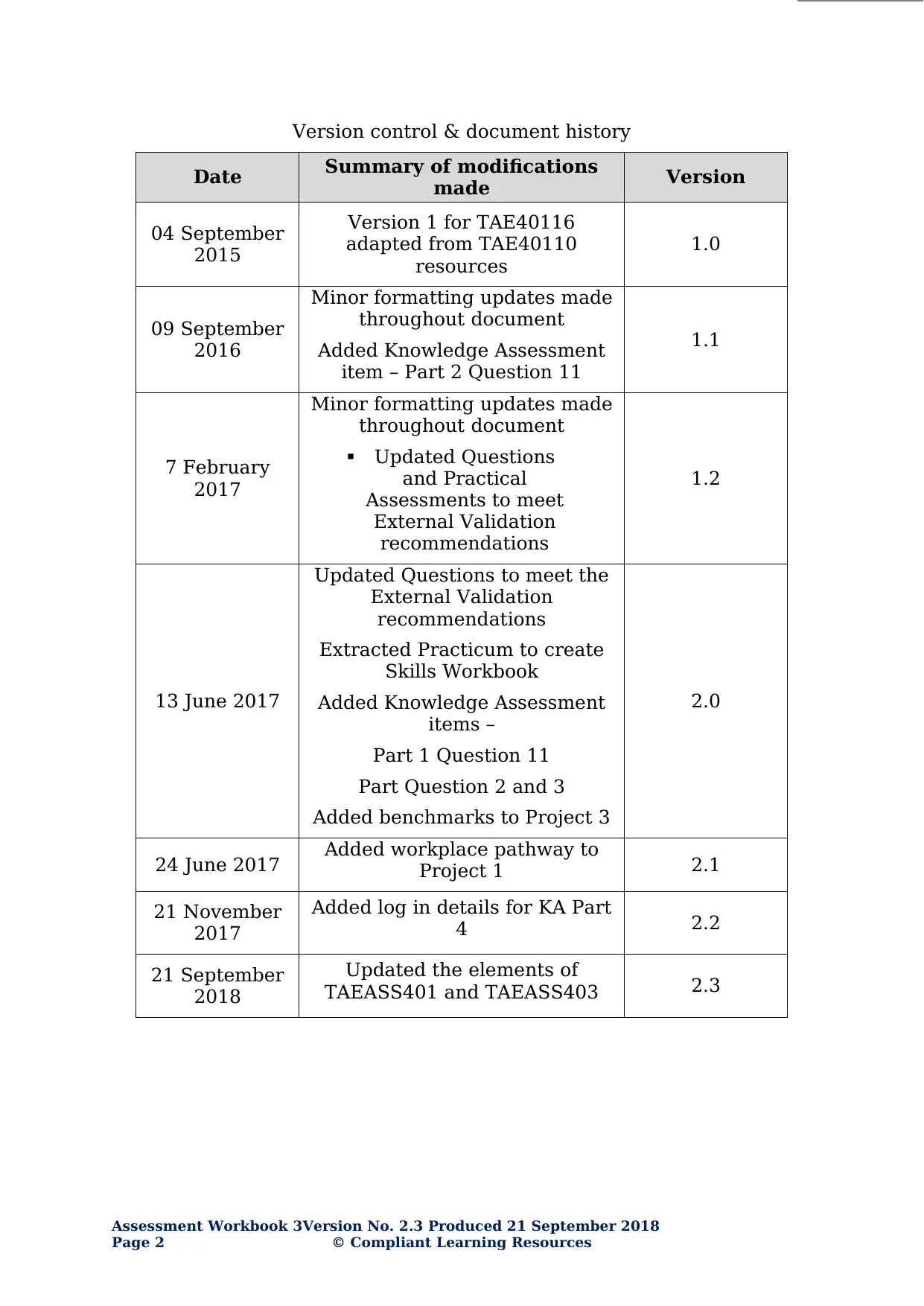
Version control & document history
Date Summary of modifications
made Version
04 September
2015
Version 1 for TAE40116
adapted from TAE40110
resources
1.0
09 September
2016
Minor formatting updates made
throughout document
Added Knowledge Assessment
item – Part 2 Question 11
1.1
7 February
2017
Minor formatting updates made
throughout document
Updated Questions
and Practical
Assessments to meet
External Validation
recommendations
1.2
13 June 2017
Updated Questions to meet the
External Validation
recommendations
Extracted Practicum to create
Skills Workbook
Added Knowledge Assessment
items –
Part 1 Question 11
Part Question 2 and 3
Added benchmarks to Project 3
2.0
24 June 2017 Added workplace pathway to
Project 1 2.1
21 November
2017
Added log in details for KA Part
4 2.2
21 September
2018
Updated the elements of
TAEASS401 and TAEASS403 2.3
Assessment Workbook 3Version No. 2.3 Produced 21 September 2018
Page 2 © Compliant Learning Resources
Date Summary of modifications
made Version
04 September
2015
Version 1 for TAE40116
adapted from TAE40110
resources
1.0
09 September
2016
Minor formatting updates made
throughout document
Added Knowledge Assessment
item – Part 2 Question 11
1.1
7 February
2017
Minor formatting updates made
throughout document
Updated Questions
and Practical
Assessments to meet
External Validation
recommendations
1.2
13 June 2017
Updated Questions to meet the
External Validation
recommendations
Extracted Practicum to create
Skills Workbook
Added Knowledge Assessment
items –
Part 1 Question 11
Part Question 2 and 3
Added benchmarks to Project 3
2.0
24 June 2017 Added workplace pathway to
Project 1 2.1
21 November
2017
Added log in details for KA Part
4 2.2
21 September
2018
Updated the elements of
TAEASS401 and TAEASS403 2.3
Assessment Workbook 3Version No. 2.3 Produced 21 September 2018
Page 2 © Compliant Learning Resources
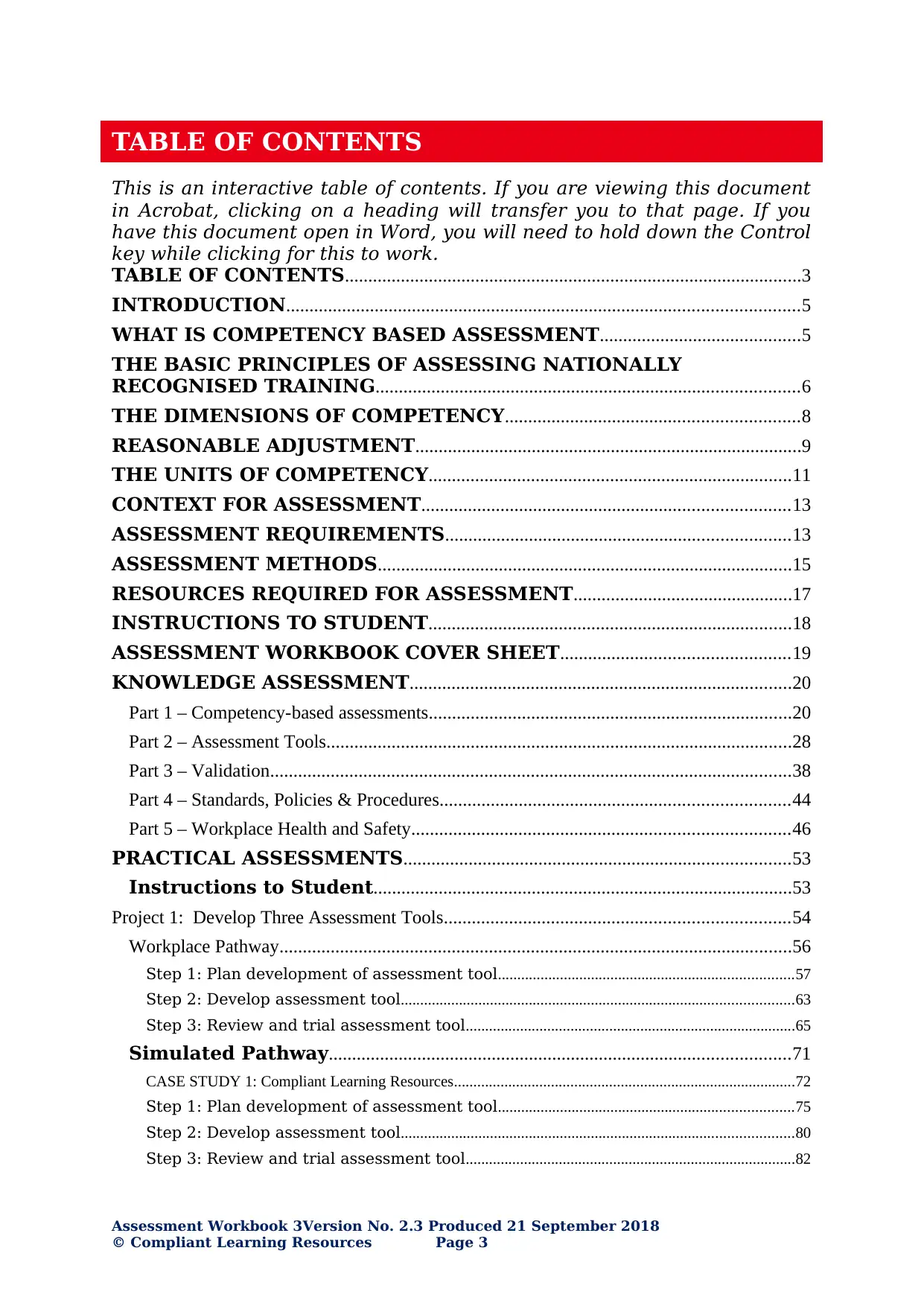
TABLE OF CONTENTS
This is an interactive table of contents. If you are viewing this document
in Acrobat, clicking on a heading will transfer you to that page. If you
have this document open in Word, you will need to hold down the Control
key while clicking for this to work.
TABLE OF CONTENTS..................................................................................................3
INTRODUCTION..............................................................................................................5
WHAT IS COMPETENCY BASED ASSESSMENT...........................................5
THE BASIC PRINCIPLES OF ASSESSING NATIONALLY
RECOGNISED TRAINING...........................................................................................6
THE DIMENSIONS OF COMPETENCY...............................................................8
REASONABLE ADJUSTMENT...................................................................................9
THE UNITS OF COMPETENCY..............................................................................11
CONTEXT FOR ASSESSMENT...............................................................................13
ASSESSMENT REQUIREMENTS..........................................................................13
ASSESSMENT METHODS.........................................................................................15
RESOURCES REQUIRED FOR ASSESSMENT...............................................17
INSTRUCTIONS TO STUDENT..............................................................................18
ASSESSMENT WORKBOOK COVER SHEET.................................................19
KNOWLEDGE ASSESSMENT..................................................................................20
Part 1 – Competency-based assessments..............................................................................20
Part 2 – Assessment Tools....................................................................................................28
Part 3 – Validation................................................................................................................38
Part 4 – Standards, Policies & Procedures...........................................................................44
Part 5 – Workplace Health and Safety.................................................................................46
PRACTICAL ASSESSMENTS...................................................................................53
Instructions to Student..........................................................................................53
Project 1: Develop Three Assessment Tools..........................................................................54
Workplace Pathway..............................................................................................................56
Step 1: Plan development of assessment tool............................................................................57
Step 2: Develop assessment tool.....................................................................................................63
Step 3: Review and trial assessment tool.....................................................................................65
Simulated Pathway...................................................................................................71
CASE STUDY 1: Compliant Learning Resources........................................................................................72
Step 1: Plan development of assessment tool............................................................................75
Step 2: Develop assessment tool.....................................................................................................80
Step 3: Review and trial assessment tool.....................................................................................82
Assessment Workbook 3Version No. 2.3 Produced 21 September 2018
© Compliant Learning Resources Page 3
This is an interactive table of contents. If you are viewing this document
in Acrobat, clicking on a heading will transfer you to that page. If you
have this document open in Word, you will need to hold down the Control
key while clicking for this to work.
TABLE OF CONTENTS..................................................................................................3
INTRODUCTION..............................................................................................................5
WHAT IS COMPETENCY BASED ASSESSMENT...........................................5
THE BASIC PRINCIPLES OF ASSESSING NATIONALLY
RECOGNISED TRAINING...........................................................................................6
THE DIMENSIONS OF COMPETENCY...............................................................8
REASONABLE ADJUSTMENT...................................................................................9
THE UNITS OF COMPETENCY..............................................................................11
CONTEXT FOR ASSESSMENT...............................................................................13
ASSESSMENT REQUIREMENTS..........................................................................13
ASSESSMENT METHODS.........................................................................................15
RESOURCES REQUIRED FOR ASSESSMENT...............................................17
INSTRUCTIONS TO STUDENT..............................................................................18
ASSESSMENT WORKBOOK COVER SHEET.................................................19
KNOWLEDGE ASSESSMENT..................................................................................20
Part 1 – Competency-based assessments..............................................................................20
Part 2 – Assessment Tools....................................................................................................28
Part 3 – Validation................................................................................................................38
Part 4 – Standards, Policies & Procedures...........................................................................44
Part 5 – Workplace Health and Safety.................................................................................46
PRACTICAL ASSESSMENTS...................................................................................53
Instructions to Student..........................................................................................53
Project 1: Develop Three Assessment Tools..........................................................................54
Workplace Pathway..............................................................................................................56
Step 1: Plan development of assessment tool............................................................................57
Step 2: Develop assessment tool.....................................................................................................63
Step 3: Review and trial assessment tool.....................................................................................65
Simulated Pathway...................................................................................................71
CASE STUDY 1: Compliant Learning Resources........................................................................................72
Step 1: Plan development of assessment tool............................................................................75
Step 2: Develop assessment tool.....................................................................................................80
Step 3: Review and trial assessment tool.....................................................................................82
Assessment Workbook 3Version No. 2.3 Produced 21 September 2018
© Compliant Learning Resources Page 3
⊘ This is a preview!⊘
Do you want full access?
Subscribe today to unlock all pages.

Trusted by 1+ million students worldwide
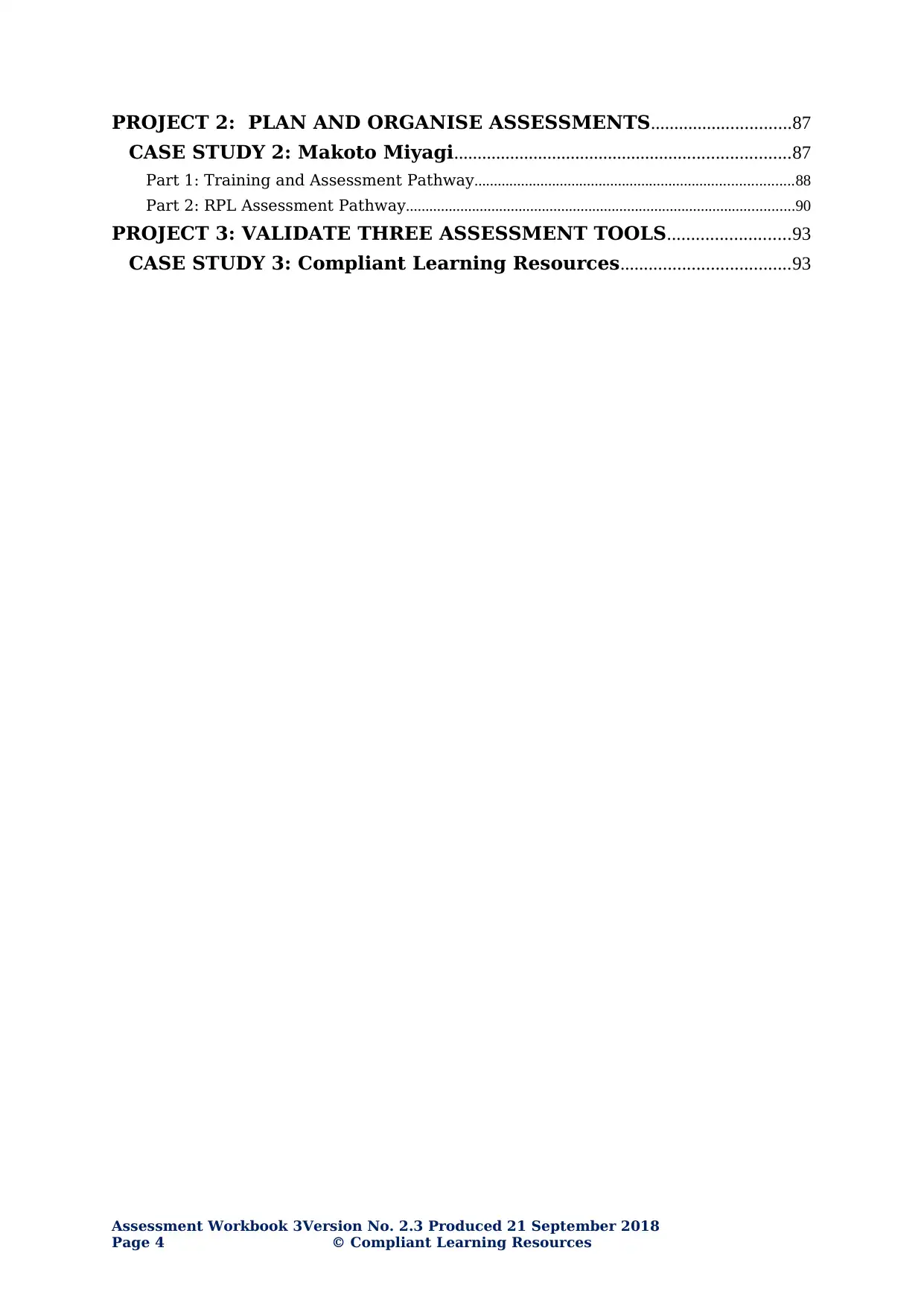
PROJECT 2: PLAN AND ORGANISE ASSESSMENTS..............................87
CASE STUDY 2: Makoto Miyagi........................................................................87
Part 1: Training and Assessment Pathway..................................................................................88
Part 2: RPL Assessment Pathway....................................................................................................90
PROJECT 3: VALIDATE THREE ASSESSMENT TOOLS..........................93
CASE STUDY 3: Compliant Learning Resources....................................93
Assessment Workbook 3Version No. 2.3 Produced 21 September 2018
Page 4 © Compliant Learning Resources
CASE STUDY 2: Makoto Miyagi........................................................................87
Part 1: Training and Assessment Pathway..................................................................................88
Part 2: RPL Assessment Pathway....................................................................................................90
PROJECT 3: VALIDATE THREE ASSESSMENT TOOLS..........................93
CASE STUDY 3: Compliant Learning Resources....................................93
Assessment Workbook 3Version No. 2.3 Produced 21 September 2018
Page 4 © Compliant Learning Resources
Paraphrase This Document
Need a fresh take? Get an instant paraphrase of this document with our AI Paraphraser
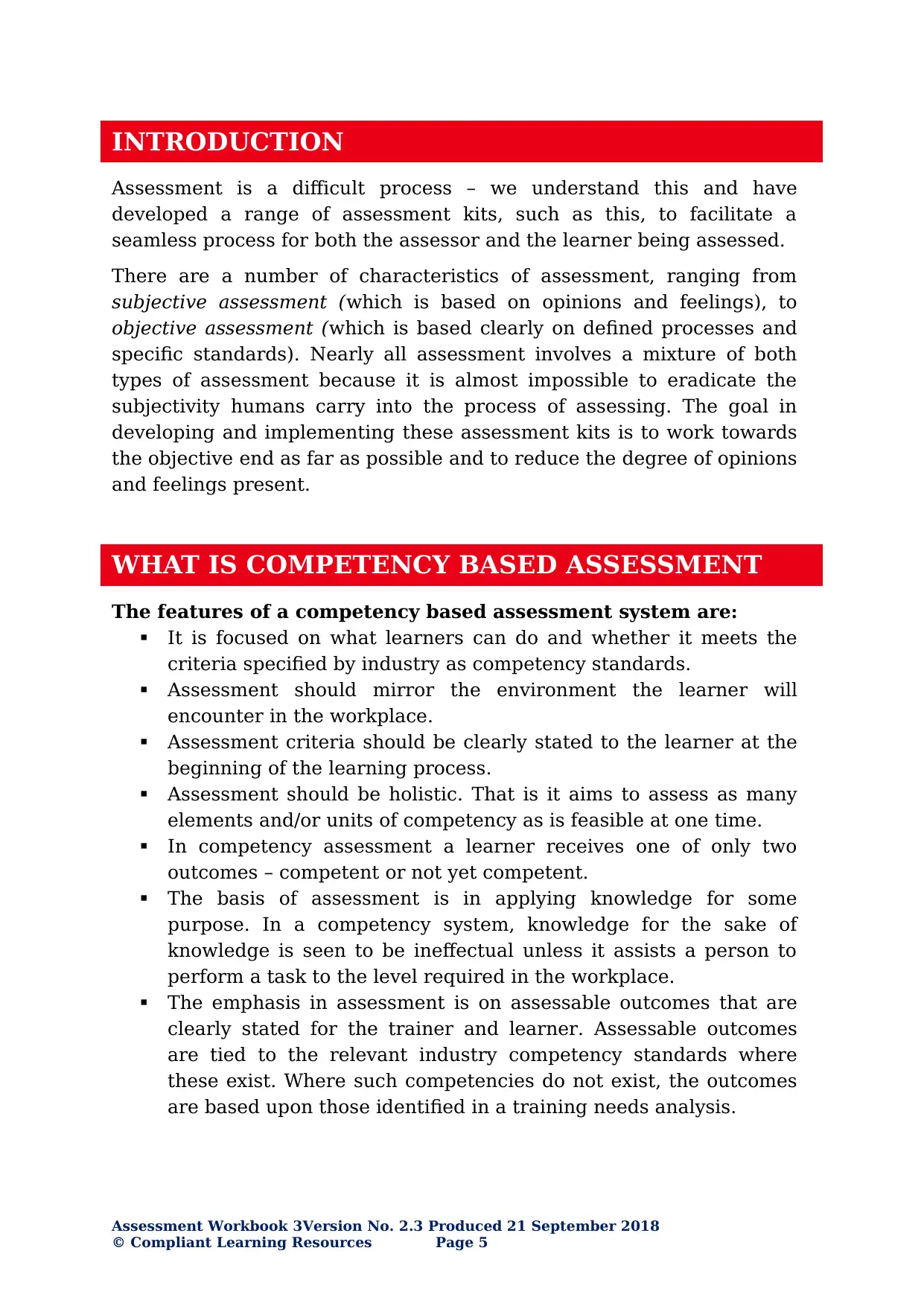
INTRODUCTION
Assessment is a difficult process – we understand this and have
developed a range of assessment kits, such as this, to facilitate a
seamless process for both the assessor and the learner being assessed.
There are a number of characteristics of assessment, ranging from
subjective assessment (which is based on opinions and feelings), to
objective assessment (which is based clearly on defined processes and
specific standards). Nearly all assessment involves a mixture of both
types of assessment because it is almost impossible to eradicate the
subjectivity humans carry into the process of assessing. The goal in
developing and implementing these assessment kits is to work towards
the objective end as far as possible and to reduce the degree of opinions
and feelings present.
WHAT IS COMPETENCY BASED ASSESSMENT
The features of a competency based assessment system are:
It is focused on what learners can do and whether it meets the
criteria specified by industry as competency standards.
Assessment should mirror the environment the learner will
encounter in the workplace.
Assessment criteria should be clearly stated to the learner at the
beginning of the learning process.
Assessment should be holistic. That is it aims to assess as many
elements and/or units of competency as is feasible at one time.
In competency assessment a learner receives one of only two
outcomes – competent or not yet competent.
The basis of assessment is in applying knowledge for some
purpose. In a competency system, knowledge for the sake of
knowledge is seen to be ineffectual unless it assists a person to
perform a task to the level required in the workplace.
The emphasis in assessment is on assessable outcomes that are
clearly stated for the trainer and learner. Assessable outcomes
are tied to the relevant industry competency standards where
these exist. Where such competencies do not exist, the outcomes
are based upon those identified in a training needs analysis.
Assessment Workbook 3Version No. 2.3 Produced 21 September 2018
© Compliant Learning Resources Page 5
Assessment is a difficult process – we understand this and have
developed a range of assessment kits, such as this, to facilitate a
seamless process for both the assessor and the learner being assessed.
There are a number of characteristics of assessment, ranging from
subjective assessment (which is based on opinions and feelings), to
objective assessment (which is based clearly on defined processes and
specific standards). Nearly all assessment involves a mixture of both
types of assessment because it is almost impossible to eradicate the
subjectivity humans carry into the process of assessing. The goal in
developing and implementing these assessment kits is to work towards
the objective end as far as possible and to reduce the degree of opinions
and feelings present.
WHAT IS COMPETENCY BASED ASSESSMENT
The features of a competency based assessment system are:
It is focused on what learners can do and whether it meets the
criteria specified by industry as competency standards.
Assessment should mirror the environment the learner will
encounter in the workplace.
Assessment criteria should be clearly stated to the learner at the
beginning of the learning process.
Assessment should be holistic. That is it aims to assess as many
elements and/or units of competency as is feasible at one time.
In competency assessment a learner receives one of only two
outcomes – competent or not yet competent.
The basis of assessment is in applying knowledge for some
purpose. In a competency system, knowledge for the sake of
knowledge is seen to be ineffectual unless it assists a person to
perform a task to the level required in the workplace.
The emphasis in assessment is on assessable outcomes that are
clearly stated for the trainer and learner. Assessable outcomes
are tied to the relevant industry competency standards where
these exist. Where such competencies do not exist, the outcomes
are based upon those identified in a training needs analysis.
Assessment Workbook 3Version No. 2.3 Produced 21 September 2018
© Compliant Learning Resources Page 5
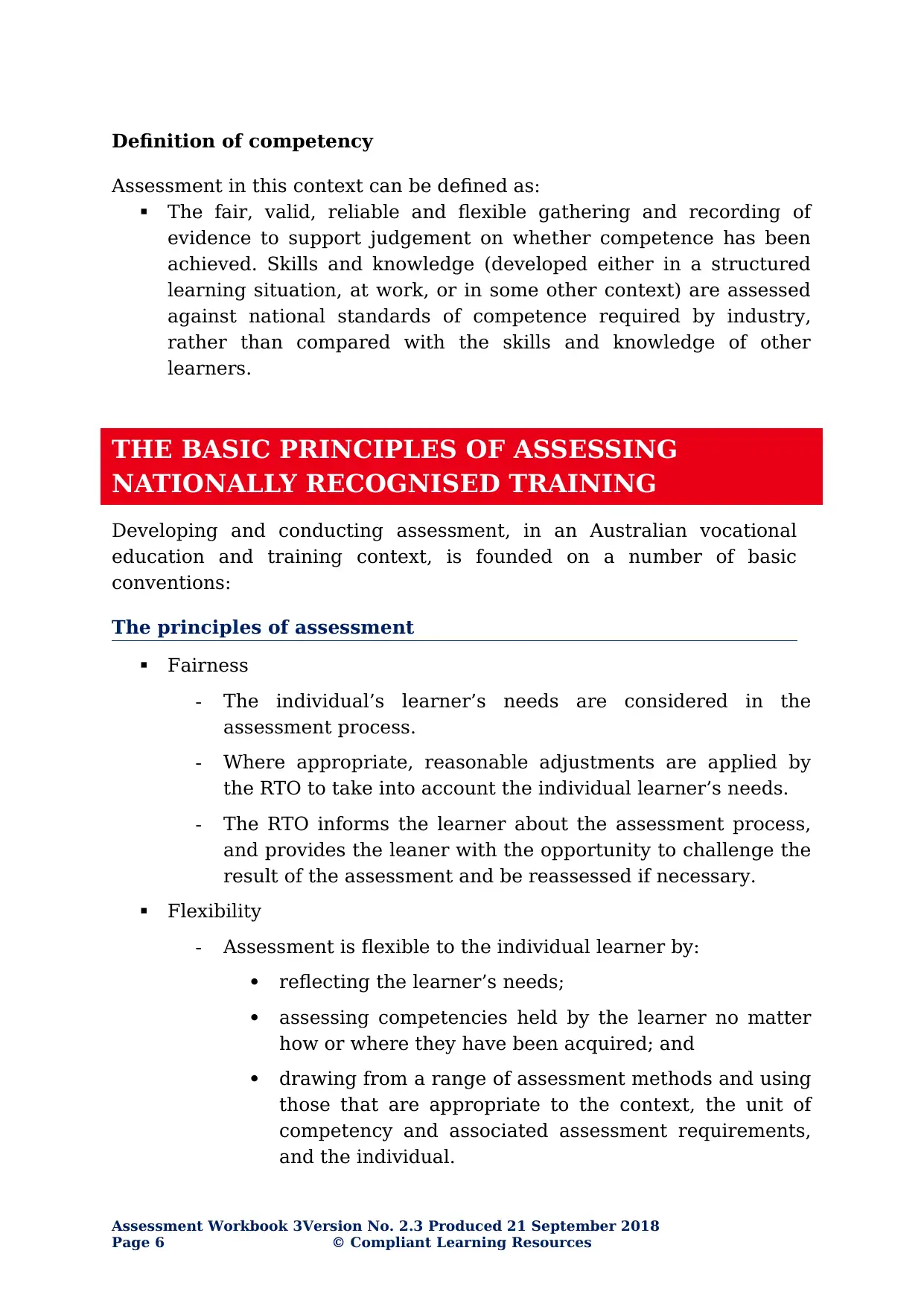
Definition of competency
Assessment in this context can be defined as:
The fair, valid, reliable and flexible gathering and recording of
evidence to support judgement on whether competence has been
achieved. Skills and knowledge (developed either in a structured
learning situation, at work, or in some other context) are assessed
against national standards of competence required by industry,
rather than compared with the skills and knowledge of other
learners.
THE BASIC PRINCIPLES OF ASSESSING
NATIONALLY RECOGNISED TRAINING
Developing and conducting assessment, in an Australian vocational
education and training context, is founded on a number of basic
conventions:
The principles of assessment
Fairness
- The individual’s learner’s needs are considered in the
assessment process.
- Where appropriate, reasonable adjustments are applied by
the RTO to take into account the individual learner’s needs.
- The RTO informs the learner about the assessment process,
and provides the leaner with the opportunity to challenge the
result of the assessment and be reassessed if necessary.
Flexibility
- Assessment is flexible to the individual learner by:
reflecting the learner’s needs;
assessing competencies held by the learner no matter
how or where they have been acquired; and
drawing from a range of assessment methods and using
those that are appropriate to the context, the unit of
competency and associated assessment requirements,
and the individual.
Assessment Workbook 3Version No. 2.3 Produced 21 September 2018
Page 6 © Compliant Learning Resources
Assessment in this context can be defined as:
The fair, valid, reliable and flexible gathering and recording of
evidence to support judgement on whether competence has been
achieved. Skills and knowledge (developed either in a structured
learning situation, at work, or in some other context) are assessed
against national standards of competence required by industry,
rather than compared with the skills and knowledge of other
learners.
THE BASIC PRINCIPLES OF ASSESSING
NATIONALLY RECOGNISED TRAINING
Developing and conducting assessment, in an Australian vocational
education and training context, is founded on a number of basic
conventions:
The principles of assessment
Fairness
- The individual’s learner’s needs are considered in the
assessment process.
- Where appropriate, reasonable adjustments are applied by
the RTO to take into account the individual learner’s needs.
- The RTO informs the learner about the assessment process,
and provides the leaner with the opportunity to challenge the
result of the assessment and be reassessed if necessary.
Flexibility
- Assessment is flexible to the individual learner by:
reflecting the learner’s needs;
assessing competencies held by the learner no matter
how or where they have been acquired; and
drawing from a range of assessment methods and using
those that are appropriate to the context, the unit of
competency and associated assessment requirements,
and the individual.
Assessment Workbook 3Version No. 2.3 Produced 21 September 2018
Page 6 © Compliant Learning Resources
⊘ This is a preview!⊘
Do you want full access?
Subscribe today to unlock all pages.

Trusted by 1+ million students worldwide

Assessment Workbook 3Version No. 2.3 Produced 21 September 2018
© Compliant Learning Resources Page 7
© Compliant Learning Resources Page 7
Paraphrase This Document
Need a fresh take? Get an instant paraphrase of this document with our AI Paraphraser
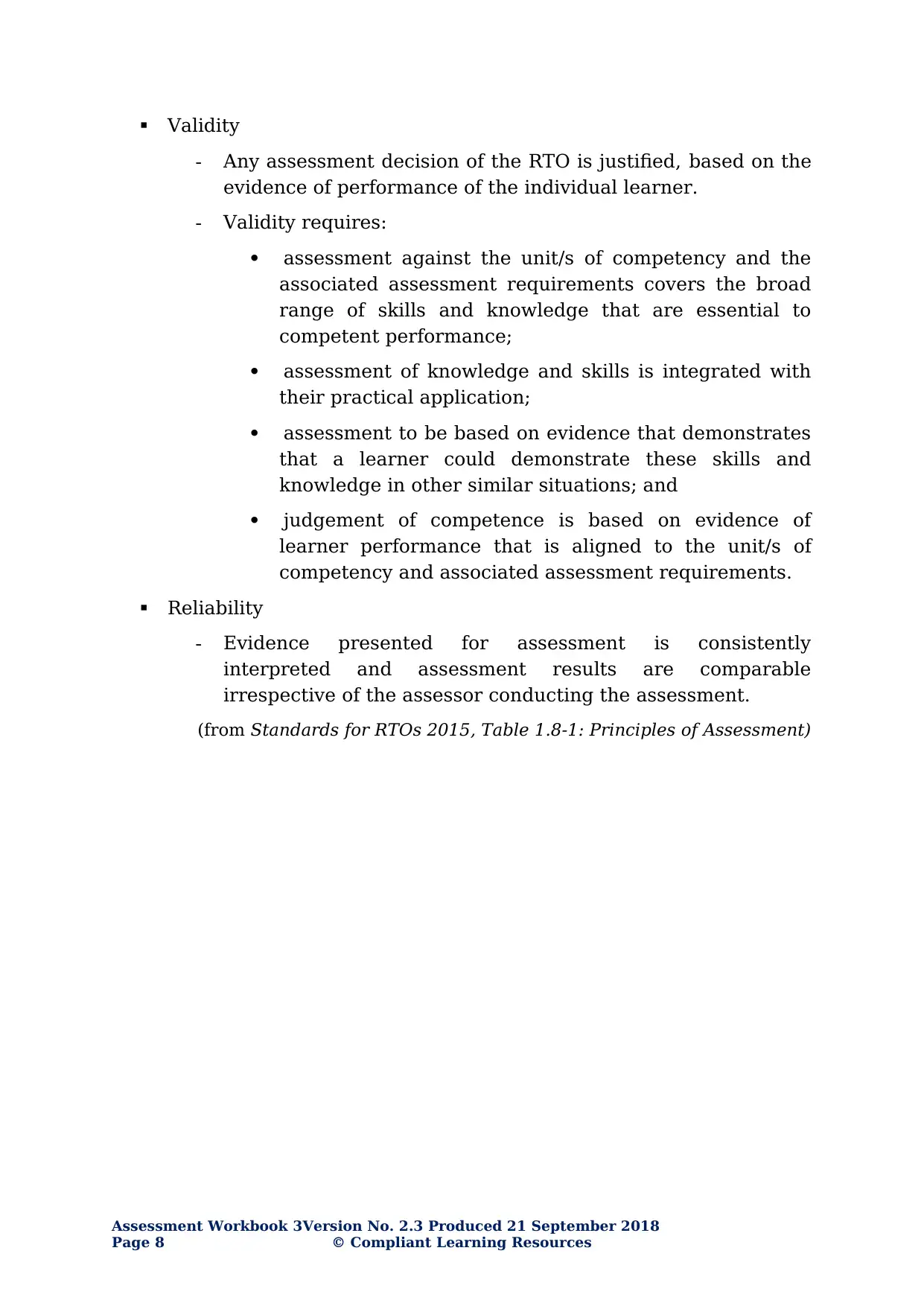
Validity
- Any assessment decision of the RTO is justified, based on the
evidence of performance of the individual learner.
- Validity requires:
assessment against the unit/s of competency and the
associated assessment requirements covers the broad
range of skills and knowledge that are essential to
competent performance;
assessment of knowledge and skills is integrated with
their practical application;
assessment to be based on evidence that demonstrates
that a learner could demonstrate these skills and
knowledge in other similar situations; and
judgement of competence is based on evidence of
learner performance that is aligned to the unit/s of
competency and associated assessment requirements.
Reliability
- Evidence presented for assessment is consistently
interpreted and assessment results are comparable
irrespective of the assessor conducting the assessment.
(from Standards for RTOs 2015, Table 1.8-1: Principles of Assessment)
Assessment Workbook 3Version No. 2.3 Produced 21 September 2018
Page 8 © Compliant Learning Resources
- Any assessment decision of the RTO is justified, based on the
evidence of performance of the individual learner.
- Validity requires:
assessment against the unit/s of competency and the
associated assessment requirements covers the broad
range of skills and knowledge that are essential to
competent performance;
assessment of knowledge and skills is integrated with
their practical application;
assessment to be based on evidence that demonstrates
that a learner could demonstrate these skills and
knowledge in other similar situations; and
judgement of competence is based on evidence of
learner performance that is aligned to the unit/s of
competency and associated assessment requirements.
Reliability
- Evidence presented for assessment is consistently
interpreted and assessment results are comparable
irrespective of the assessor conducting the assessment.
(from Standards for RTOs 2015, Table 1.8-1: Principles of Assessment)
Assessment Workbook 3Version No. 2.3 Produced 21 September 2018
Page 8 © Compliant Learning Resources
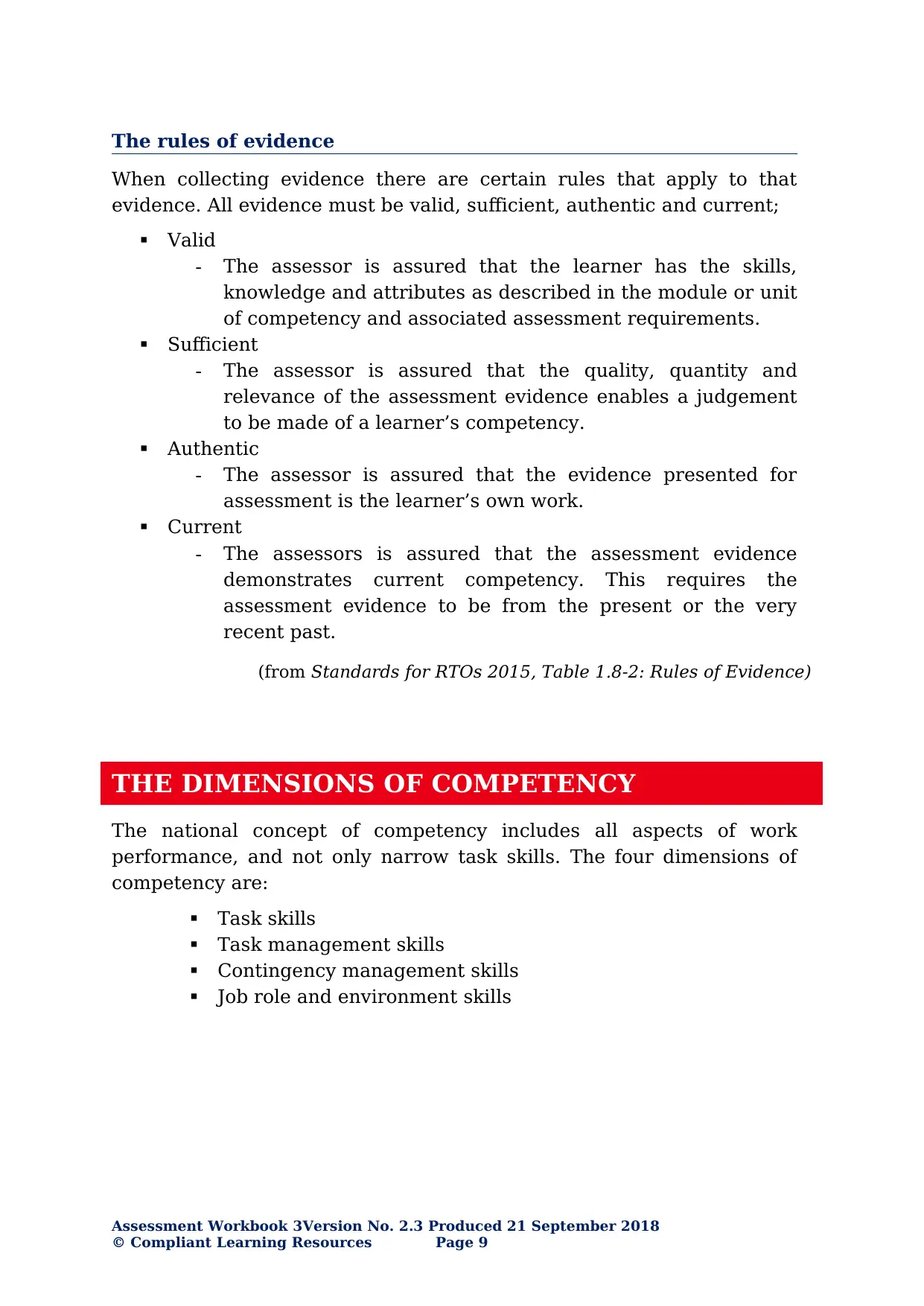
The rules of evidence
When collecting evidence there are certain rules that apply to that
evidence. All evidence must be valid, sufficient, authentic and current;
Valid
- The assessor is assured that the learner has the skills,
knowledge and attributes as described in the module or unit
of competency and associated assessment requirements.
Sufficient
- The assessor is assured that the quality, quantity and
relevance of the assessment evidence enables a judgement
to be made of a learner’s competency.
Authentic
- The assessor is assured that the evidence presented for
assessment is the learner’s own work.
Current
- The assessors is assured that the assessment evidence
demonstrates current competency. This requires the
assessment evidence to be from the present or the very
recent past.
(from Standards for RTOs 2015, Table 1.8-2: Rules of Evidence)
THE DIMENSIONS OF COMPETENCY
The national concept of competency includes all aspects of work
performance, and not only narrow task skills. The four dimensions of
competency are:
Task skills
Task management skills
Contingency management skills
Job role and environment skills
Assessment Workbook 3Version No. 2.3 Produced 21 September 2018
© Compliant Learning Resources Page 9
When collecting evidence there are certain rules that apply to that
evidence. All evidence must be valid, sufficient, authentic and current;
Valid
- The assessor is assured that the learner has the skills,
knowledge and attributes as described in the module or unit
of competency and associated assessment requirements.
Sufficient
- The assessor is assured that the quality, quantity and
relevance of the assessment evidence enables a judgement
to be made of a learner’s competency.
Authentic
- The assessor is assured that the evidence presented for
assessment is the learner’s own work.
Current
- The assessors is assured that the assessment evidence
demonstrates current competency. This requires the
assessment evidence to be from the present or the very
recent past.
(from Standards for RTOs 2015, Table 1.8-2: Rules of Evidence)
THE DIMENSIONS OF COMPETENCY
The national concept of competency includes all aspects of work
performance, and not only narrow task skills. The four dimensions of
competency are:
Task skills
Task management skills
Contingency management skills
Job role and environment skills
Assessment Workbook 3Version No. 2.3 Produced 21 September 2018
© Compliant Learning Resources Page 9
⊘ This is a preview!⊘
Do you want full access?
Subscribe today to unlock all pages.

Trusted by 1+ million students worldwide
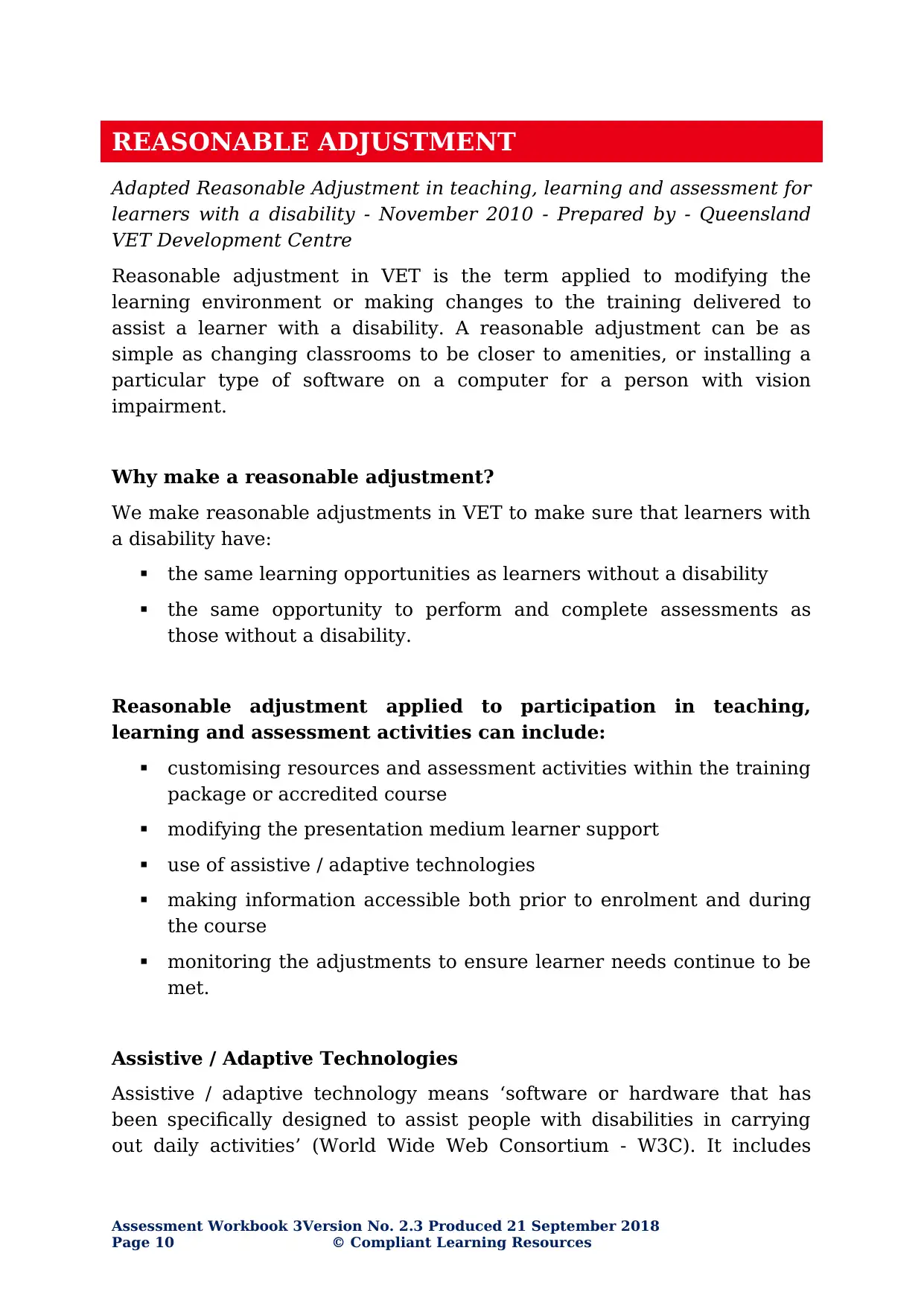
REASONABLE ADJUSTMENT
Adapted Reasonable Adjustment in teaching, learning and assessment for
learners with a disability - November 2010 - Prepared by - Queensland
VET Development Centre
Reasonable adjustment in VET is the term applied to modifying the
learning environment or making changes to the training delivered to
assist a learner with a disability. A reasonable adjustment can be as
simple as changing classrooms to be closer to amenities, or installing a
particular type of software on a computer for a person with vision
impairment.
Why make a reasonable adjustment?
We make reasonable adjustments in VET to make sure that learners with
a disability have:
the same learning opportunities as learners without a disability
the same opportunity to perform and complete assessments as
those without a disability.
Reasonable adjustment applied to participation in teaching,
learning and assessment activities can include:
customising resources and assessment activities within the training
package or accredited course
modifying the presentation medium learner support
use of assistive / adaptive technologies
making information accessible both prior to enrolment and during
the course
monitoring the adjustments to ensure learner needs continue to be
met.
Assistive / Adaptive Technologies
Assistive / adaptive technology means ‘software or hardware that has
been specifically designed to assist people with disabilities in carrying
out daily activities’ (World Wide Web Consortium - W3C). It includes
Assessment Workbook 3Version No. 2.3 Produced 21 September 2018
Page 10 © Compliant Learning Resources
Adapted Reasonable Adjustment in teaching, learning and assessment for
learners with a disability - November 2010 - Prepared by - Queensland
VET Development Centre
Reasonable adjustment in VET is the term applied to modifying the
learning environment or making changes to the training delivered to
assist a learner with a disability. A reasonable adjustment can be as
simple as changing classrooms to be closer to amenities, or installing a
particular type of software on a computer for a person with vision
impairment.
Why make a reasonable adjustment?
We make reasonable adjustments in VET to make sure that learners with
a disability have:
the same learning opportunities as learners without a disability
the same opportunity to perform and complete assessments as
those without a disability.
Reasonable adjustment applied to participation in teaching,
learning and assessment activities can include:
customising resources and assessment activities within the training
package or accredited course
modifying the presentation medium learner support
use of assistive / adaptive technologies
making information accessible both prior to enrolment and during
the course
monitoring the adjustments to ensure learner needs continue to be
met.
Assistive / Adaptive Technologies
Assistive / adaptive technology means ‘software or hardware that has
been specifically designed to assist people with disabilities in carrying
out daily activities’ (World Wide Web Consortium - W3C). It includes
Assessment Workbook 3Version No. 2.3 Produced 21 September 2018
Page 10 © Compliant Learning Resources
Paraphrase This Document
Need a fresh take? Get an instant paraphrase of this document with our AI Paraphraser
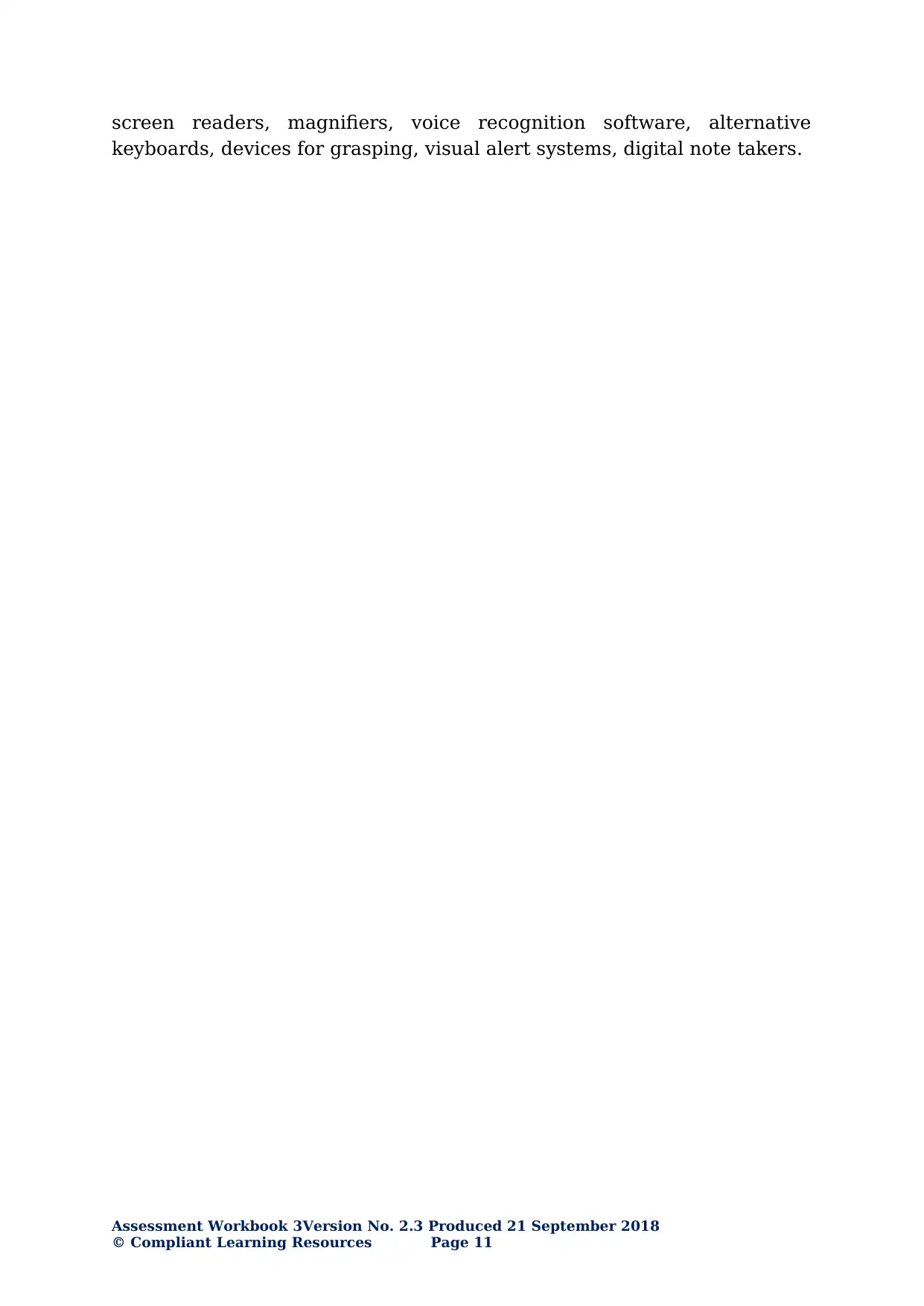
screen readers, magnifiers, voice recognition software, alternative
keyboards, devices for grasping, visual alert systems, digital note takers.
Assessment Workbook 3Version No. 2.3 Produced 21 September 2018
© Compliant Learning Resources Page 11
keyboards, devices for grasping, visual alert systems, digital note takers.
Assessment Workbook 3Version No. 2.3 Produced 21 September 2018
© Compliant Learning Resources Page 11
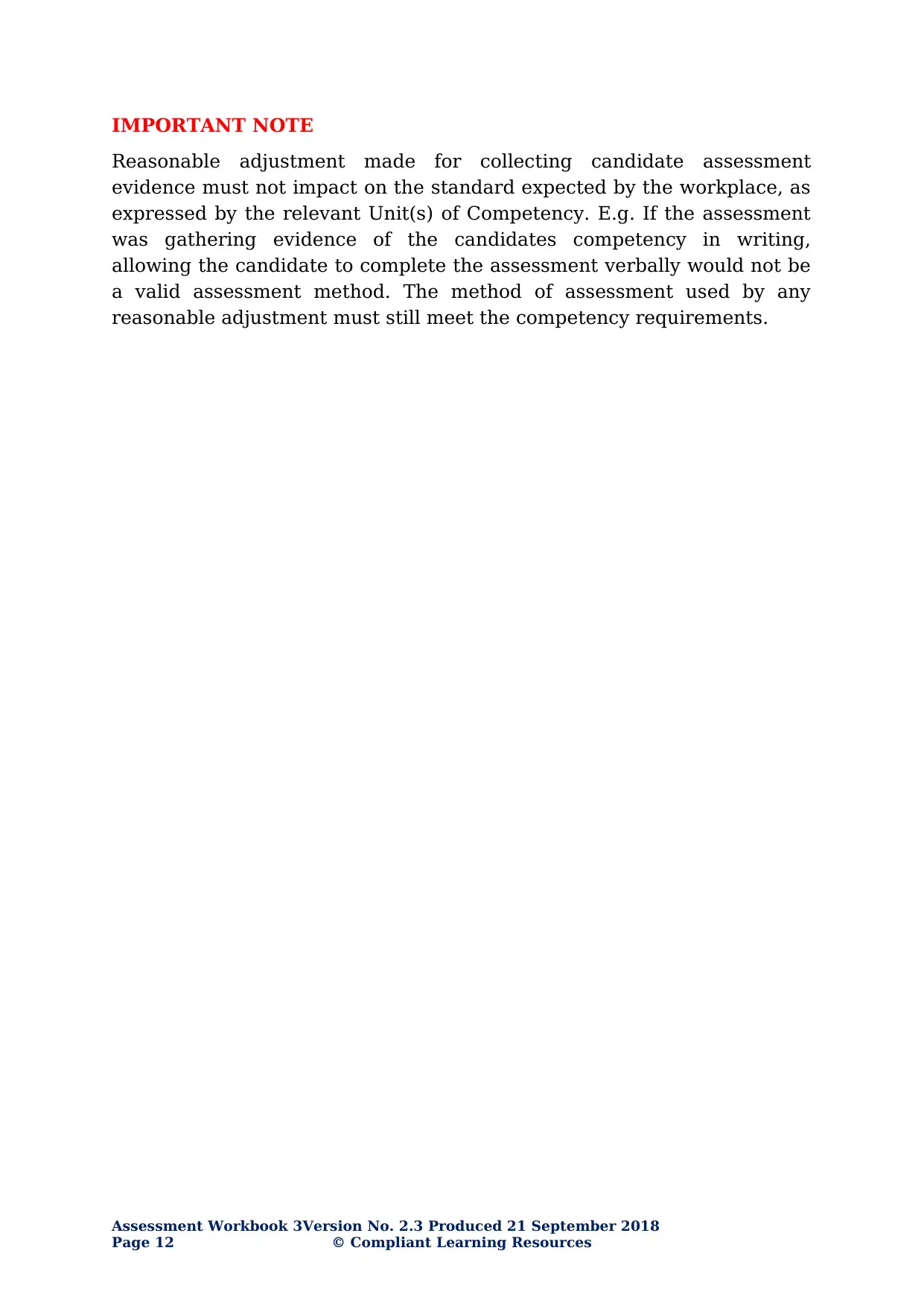
IMPORTANT NOTE
Reasonable adjustment made for collecting candidate assessment
evidence must not impact on the standard expected by the workplace, as
expressed by the relevant Unit(s) of Competency. E.g. If the assessment
was gathering evidence of the candidates competency in writing,
allowing the candidate to complete the assessment verbally would not be
a valid assessment method. The method of assessment used by any
reasonable adjustment must still meet the competency requirements.
Assessment Workbook 3Version No. 2.3 Produced 21 September 2018
Page 12 © Compliant Learning Resources
Reasonable adjustment made for collecting candidate assessment
evidence must not impact on the standard expected by the workplace, as
expressed by the relevant Unit(s) of Competency. E.g. If the assessment
was gathering evidence of the candidates competency in writing,
allowing the candidate to complete the assessment verbally would not be
a valid assessment method. The method of assessment used by any
reasonable adjustment must still meet the competency requirements.
Assessment Workbook 3Version No. 2.3 Produced 21 September 2018
Page 12 © Compliant Learning Resources
⊘ This is a preview!⊘
Do you want full access?
Subscribe today to unlock all pages.

Trusted by 1+ million students worldwide
1 out of 96
Related Documents
Your All-in-One AI-Powered Toolkit for Academic Success.
+13062052269
info@desklib.com
Available 24*7 on WhatsApp / Email
![[object Object]](/_next/static/media/star-bottom.7253800d.svg)
Unlock your academic potential
Copyright © 2020–2025 A2Z Services. All Rights Reserved. Developed and managed by ZUCOL.




